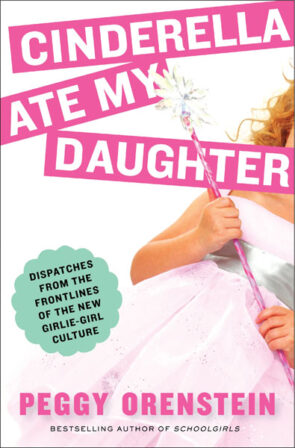$25.99; HarperCollins; 244 pages, 2011
In his poem, “Gloss of the Past,” the poet David Trinidad, a gay man, invokes a hypnotic litany of names of lip glosses from his childhood, all in various shades of pink: “Pink Dawn, Aurora Pink, Misty Pink…Pink Peony…” Today, such a profound fealty to pink is supposed to indicate some greater truth about gender. Girls (and gay men) like pink and dolls; boys like blue and guns.
But as Peggy Orenstein reminds us, up until the early 20th century, pink was considered simply a paler version of the more “masculine” red and little boys were dressed in it. Orenstein herself remembers a 1926 photo of her infant father in a pink dress.
So we know that gender presentation is largely historically contingent. What worries Orenstein, the mother of an 8-year-old girl named Daisy, is that today’s media and entertainment industry have colluded to create an overtly feminized stereotype for young girls that is simultaneously hyper-sexualized and disempowering with its constant reminder that girls need to be more concerned about their appearance than with their skills.
Like so many women born and raised in the heyday of second-wave feminism, Orenstein had several theories about raising a daughter: “Shopping for her layette, I grumbled over the relentless color coding of babies. Who cared whether the crib sheets were pink or glen plaid?”
Anyone who has had a daughter in the last decade knows what happened next. Daisy confidently took along her Thomas the Tank Engine lunchbox to preschool. But it only took “one boy who…yelled, ‘Girls don’t like trains!’ and Thomas was shoved to the bottom of the toy chest.” Orenstein learned what the Borg told Picard with implacable confidence: Resistance Is Futile. Daisy and her mother were now swept up in an endless barrage of Pinkitude and Cinderella dolls from which even Buffy the Vampire Slayer, she of the sarcasm and disdain for girliness, would not have emerged unscathed.
Cinderella Ate My Daughter is Orenstein’s chronicle of her attempts to navigate a culture that wraps girls as young in six in blinding shades of pink and in midriff-baring tops. In addition, it insists that girls suffer uniformly from the Cinderella syndrome: Wait slavishly for Prince Charmings to make their lives complete.
Orenstein sets out to find the roots of such fantasies, and the results are some interesting chapters like one on child beauty pageants, titled “Sparkle, Sweetie” (the phrase used by Shirley Temple’s mother before the precocious tot went on stage). In “Just Between You, Me, and My 622 BFFs,” she looks at the online world where girls teach themselves rules of camaraderie and, sadly, bullying straight out of Gossip Girls. Ostensibly, Orenstein wants a world where her daughter is neither desexualized (she’s clear that she wants her to have, in her adult years, a healthy sex life) nor treated as merely a commodity for toy companies or men.
Yet, Orenstein leaves the reader wondering: If princess culture is not what she wants for Daisy, what does she want? The answer comes in her critique of what she labels “revisionist, modern-day books” which “seem to equate ‘pro-girl’ with ‘anti-boy’…” In The Paper Bag Princess, she complains, the heroine dumps an ungrateful prince “and skips off into the sunset happily ever after, alone.” That’s a problem for Orenstein, who thinks, “that’s not progress, that’s payback.” Or, as she puts it about her aspirations for her daughter, “I do not want her to be a fish without a bicycle; I want her to be a fish with another fish…I hope she will find her Prince (or Princess) Charming and make me a grandma.”
That fear, that such texts impose a no-men/partner philosophy, would be legitimate only if it were the case that little girls everywhere are being inundated with a plethora of alternative texts that ask them to think of partners as the enemy. But it’s not, and Orenstein’s knee-jerk and reactionary comment reveals her rather limited view of what Daisy’s life should look like. The point of her book appears to be that girls are being driven into stereotypical roles. So why is a woman who eschews the role of wife and genuinely has no need for a partner (despite Orenstein’s political correctness, the entire book assumes that girls are born straight) considered incomplete?
Orenstein’s worrying is predicated entirely on the relationship of girls to boys/girls (a topic that consumes her) and to a very narrow conception of a happy nuclear family. Ultimately, her enormous anxiety seems to be less about what the girlie-girl culture might do to her daughter than to the fear that her daughter will not, in fact, be girl enough.
She concludes with a bland statement about how “wanting to see girls to see themselves from the inside out rather than outside in…will go a long way toward helping them find their true happily-ever-afters.” In a world where parenting feels like a constant battle against media manipulation, this simple message may be perfect for harried mothers. But surely wanting a better world for the young girls in our lives demands more imagination and daring than the fairy-tale endings that Orenstein can’t seem to let go.
****
Originally published in Windy City Times, January 26, 2011
